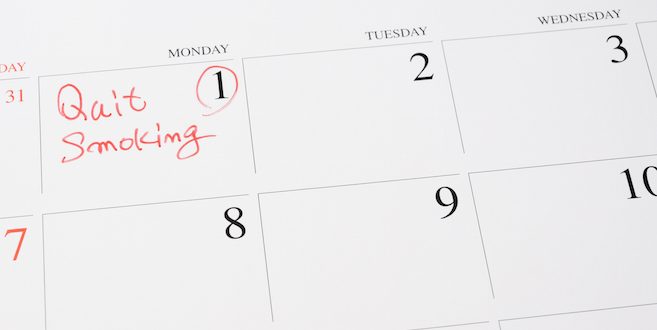Let’s face it: quitting smoking is really hard! Breaking free from an addiction is probably one of the most difficult things a person can do. So, if you’re thinking about quitting, a great way to help you ensure that you’re successful is to prepare is a quit plan in advance.
Making a plan can help keep you focused, confident and motivated to quit. It can also help you identify the challenges you’ll face as you quit and ways to overcome them. In this way, you’ll improve your chances of quitting smoking for good! So, what does a quit plan involve? We’ll outline the steps below.
Pick a date to quit
Whether it’s next week or next month, choose a date that’s right for you. Many smokers choose a quit date of about two weeks in the future, to give themselves time to prepare. Other people use a “milestone” day such as their birthday or New Year’s Day, for example. Above all, avoid choosing a day where you’ll be stressed or tempted to smoke (for example, a night out with friends or days where you may smoke at work).
If you've had trouble quitting before, breaking quitting into manageable steps using a program to cut back (for example, Nicorette’s Reduce to Quit program) can increase your chances of quitting success by four times. The program allows you to gradually reduce your cigarette intake, while managing your nicotine cravings and withdrawal symptoms with nicotine gum until you're ready to quit for good. Here’s how it works:
- 0 to 6 weeks – ease Into it: Identify the cigarettes that matter the least in your daily routine and replace them with nicotine gum.
- 6 to 16 weeks – cut down by 50%: Set goals to try and get rid of some of the cigarettes that are more difficult to give up – first of the day, after a meal etc. – while using nicotine gum to manage the cravings and withdrawal symptoms you're bound to experience. By 16 weeks, you should aim to be smoking half the amount of daily cigarettes as when you started the program.
- 16 to 24 weeks – the home stretch: Continue to eliminate cigarettes from your daily routine while managing your cravings and withdrawal symptoms with nicotine gum. Within these last 3 months, you will have lessened your dependence on cigarettes and will be more ready to give them up entirely. Once you've quit for good, if you have the occasional urge to smoke, use nicotine gum to get you through it.
Choose the method that’s right for you
Take the time to understand where and how you smoke, and mentally prepare to break your smoking patterns and deal with possible withdrawal symptoms. Part of your preparation may include considering a nicotine replacement therapy (NRT) that’s right for you. NRT comes in many forms, including gum, transdermal patches, mouth sprays, inhalers and lozenges. For more information about NRT, click here.
Let your family and friends know that you’re going to quit
Quitting smoking is easier with support from the people in your life who are important to you. Let them know ahead of your quit date that you are planning to quit. If you keep it to yourself, it might be easier to change your mind. Telling your family and friends – and even your co-workers – gives you more reasons to stay focused. It will also encourage them to help you when you need support.
Your friends and family won’t always be able to predict what you need during your quit. Be specific about what support you want (and don’t want). For example, if you’re feeling stressed after a long day at work and craving a cigarette, tell a friend and ask them to help you plan a smoke-free activity to help distract you.
List the reasons why you want to quit
Everyone has their own unique reasons for wanting to quit smoking. Maybe you want to be healthier, save money, keep your family safe, or set a good example for your children. Make a list of all the reasons why quitting is a good idea, and review it every day; all of these reasons can inspire you to stop smoking for good. After you quit smoking, your list will also help you stay motivated to remain smoke-free.
Remove all reminders of smoking
Get rid of all the “trappings” of your smoking habit. These includes cigarettes, matches, ashtrays and lighters. Removing all reminders of your smoking habit is one way of ensuring that you won’t be tempted to smoke. It’s a good idea to wash any clothes that smell like smoke. If you smoked in your car, clean it out, too. You don’t want to see or smell anything that reminds you of smoking.
Identify your smoking triggers
When you smoke, it becomes tied to many parts of your life, and certain activities and people are linked to your smoking. When you come across these things, it may trigger an urge to smoke. Try to anticipate these smoking triggers and figure out ways to deal with them. For tips about fighting cravings and staying smoke-free, click here.
Have a strategy for dealing with withdrawal symptoms
In the hours and days after you quit, you’ll continue to crave nicotine and most likely experience some symptoms of withdrawal. These include feeling restless, angry or sad, or having difficulty concentrating. You may also experience coughing fits, or have trouble sleeping for a while. The upside is that these symptoms are temporary; learn to recognize and work through them.
Remember: you may have withdrawal symptoms for a week or two, but the benefits of quitting will stay with you for the rest of your life! Here are some of the short- and long-term benefits of quitting smoking:
- Within 20 minutes of quitting: Your blood pressure and pulse rate drop to normal and the temperature of your hands and feet increases to normal.
- Within eight hours of quitting: Your blood carbon monoxide levels drop and your blood oxygen levels increase to normal levels.
- Within 24 hours of quitting: Your risk of a sudden heart attack goes down.
- Within 48 hours of quitting: Your nerve endings begin to regrow. Your senses of smell and taste begin to return to normal.
- Within two weeks to three months of quitting: Your circulation improves. Walking becomes easier. Your lungs work better. Wounds heal more quickly.
- Within one to nine months of quitting: You have more energy. Smoking-related symptoms, such as coughing, fatigue, and shortness of breath improve. You will have fewer illnesses, colds, and asthma attacks.
- Within one year of quitting: Your risk of heart disease is half that of someone still using tobacco.
- Within five years of quitting: Your risk of mouth, throat, esophagus and bladder cancers are reduced by half.
- Within 10 years of quitting: Your risk of dying from lung cancer is about one half that of a person who still smokes.
Think about how you’ll reward yourself when you’re a non-smoker!
Quitting smoking happens one minute, one hour and one day at a time. Reward yourself throughout your quit journey. Celebrate all your milestones – both big and small. Quitting smoking is hard, so celebrate and be proud of your accomplishments!
 Diabetes Care Community Learn, connect and care
Diabetes Care Community Learn, connect and care



